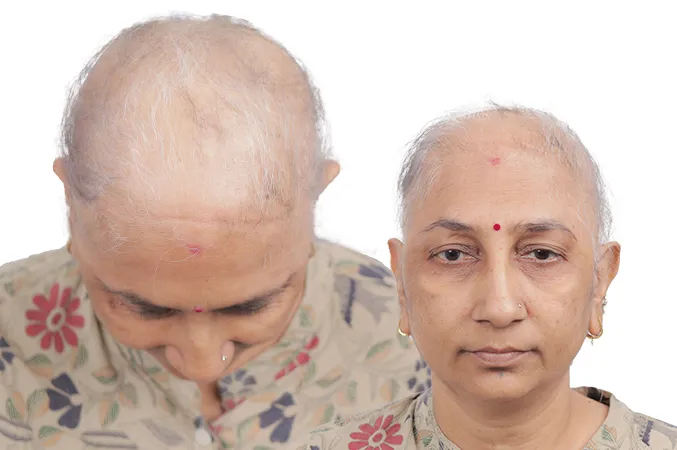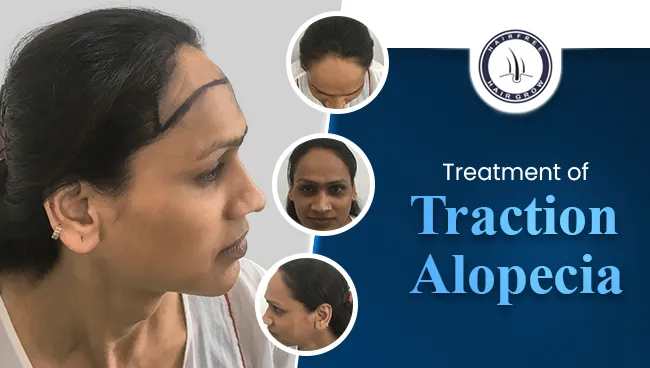
Vegan Hair Loss: Expert Tips and Advice
Have you recently transitioned to a vegan lifestyle and noticed that your hair isn’t as vibrant and healthy as it

Traction Alopecia is a form of acquired hair loss that results from prolonged or repetitive tension to the scalp hair. It was first described in 1907 in patients hailing from Greenland who had been diagnosed with hair loss after wearing hair in tight ponytails for longer periods.
Traction alopecia is a form of hair loss in which mechanical damage to the hair follicle is caused by repeated tension or pulling. Ballerinas, gymnasts, military personnel and certain professionals who are required to wear their hair pulled back, may develop traction alopecia.
When your hair is pulled for prolonged periods it starts getting loose from the follicles and eventually breaks and falls off. The hair follicles are subjected to constant pulling, they get more and more damaged and scarred that they are no longer able to produce any new hair.

Regularly wearing your hair in tight ponytails, buns, braids, dreadlocks.
Using relaxers and rollers on hair.
Having longer beard and hair and twisting and braiding it, increases its weight and causes submandibular traction alopecia.
The likelihood of traction alopecia increases with age and also from what age you started to put pressure on your hair. There are different phases in this type of hair fall and only getting a consultancy from the best hair transplant clinic in India will provide you with the best solution.
Hair weaves or extensions the tension at the hair roots may result from extensions being bonded or tightly knotted to the base of the hair.
Where the headwear makes contact with the hair, such as with sports helmets or tight elastic headbands, the hair may begin to thin.
Hair ornaments, such as grips or slides that are worn consistently throughout the day.
The weight of very long hair may tug on the hair follicles. Tightly knotted beards or extremely long beards can also cause traction alopecia.
Chemical treatments like hair relaxers. These cause the hair shaft’s structure to change in a way that increases the likelihood of hair loss.
Combining extensions with relaxers. This was the most significant risk factor for traction alopecia, according to one study Trusted Source.

If as all possible, avoid tight haircuts. If a person’s occupation or religion dictates that they wear their hair up or in tight buns, they should tie their hair as loosely as possible and wear it down or loose as often as feasible.
Limit your exposure to chemicals, including relaxants. A relaxer should not be applied to relaxed hair. To avoid putting undue stress on one part of the scalp, switch up your hairstyle every few weeks.
Look into hair-growth products. After three to six months of using a minoxidil treatment, about 40% of users begin to experience some hair growth again.
Minoxidil, Hair Transplant, topical antifungal shampoo can help.
If you have a painful hairdo, loosen it or modify it.
Wear thick, loose braids rather than short, tight braids and switch up your hairstyles every few weeks.
Swap the elastic hair ties for cloth ones.
Keep your hair as loose as you can.
If you’re facing hair loss or baldness, consider visiting Hairfree Hairgrow, the best hair transplant clinic in India. With branches in Pune, Surat, Kolkata, Bhopal, Gurugram, Hyderabad, and Ahmedabad, we offer top-notch services.
At our clinic, we specialize in Traction Alopecia treatment as well. If you’re curious about the cost of this treatment, simply click on “hair transplant cost” to learn more.

Have you recently transitioned to a vegan lifestyle and noticed that your hair isn’t as vibrant and healthy as it

The man-bun hairstyle, while not as trendy as it once was, remains a popular choice among certain subcultures. However, if

While alcohol itself doesn’t directly cause hair loss, excessive drinking can contribute to it by hindering nutrient absorption, causing dehydration,
Find Out in 3 Minutes, Your Hair Problem Solution.
Traction alopecia is hair loss caused by constant pulling or tension on the hair. It often results from tight hairstyles like ponytails, braids, buns, or extensions. Over time, this stress damages the hair follicles, leading to thinning or bald patches, especially around the hairline and temples. It’s more common in women.
If caught early, traction alopecia can often be reversed by simply stopping the tension-causing hairstyle. Hair may start growing back within a few months. Natural oils, gentle scalp massages, and avoiding heat or chemicals can help, but if scarring occurs, regrowth without medical treatment becomes difficult.
Traction alopecia usually causes thinning around the hairline or where the hair is pulled most. If your hair loss follows the pattern of your hairstyle tension, it’s likely traction-related. Unlike other types, it doesn’t usually affect the crown. A dermatologist can confirm it with a scalp exam or trichoscopy.
You may notice hair thinning along your hairline, small broken hairs, or a receding edge. The scalp might feel sore or itchy. Red bumps or inflammation can also appear. Catching these signs early and changing your hairstyle can prevent permanent damage to the follicles.
Yes, regrowth is possible if the damage isn’t too severe. In early stages, stopping tight hairstyles and treating the scalp gently can help hair grow back within 3–6 months. But if scarring or long-term damage has occurred, hair transplant surgery might be needed to restore hair.
Avoid tight ponytails, cornrows, buns, braids, and hair extensions that pull on the scalp. Also, skip styles that stress the same area daily. Letting your hair down, wearing it loosely, and changing your part regularly can reduce the tension and keep follicles healthy.
At HairFreeHairGrow, treatment starts with identifying the stage of hair loss. Early cases may be treated with PRP therapy, topical medications, or lifestyle changes. In advanced stages with scarring, a hair transplant may be suggested. The team customizes each plan for effective, lasting results.
Yes, a hair transplant can offer a permanent solution if the follicles are too damaged to regrow naturally. Healthy hair follicles from another part of your scalp are transplanted to the affected area. The results are natural-looking and long-lasting, especially when combined with proper hair care post-procedure.
Recovery time depends on how early it’s diagnosed. If treated early, hair can begin growing back in 3 to 6 months. For more advanced cases needing medical treatments or hair transplants, full recovery may take 6 to 12 months. Regular follow-ups help monitor progress.
If traction continues for a long time, it can permanently damage hair follicles, leading to scarring and bald spots. In such cases, natural regrowth isn’t possible, and treatments like hair transplants become the best option. Early intervention is key to preventing irreversible damage.